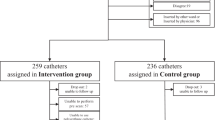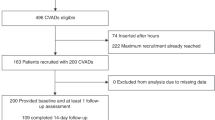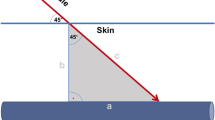Summary:
The so-called pinch-off syndrome is observed in up to 1% of all central venous catheters (CVCs), and is a valuable warning prior to fragmentation, which occurs in approximately 40% of the respective cases. As long-term indwelling CVCs are used with increasing frequency, this paper describes the necessity of pinch-off monitoring following the experiences of a case study and a review of the current literature on this specific topic in order to point out preventive practice guidelines.
Besides easy preventive practices such as a high level of suspicion and adequate X-ray controls, findings give strong evidence that the most important specific factor might be the adequate approach.
In our hands, the supraclavicular technique has provided the best results with regards to percutaneous introduction of large bore CVCs.
This is a preview of subscription content, access via your institution
Access options
Subscribe to this journal
Receive 12 print issues and online access
$259.00 per year
only $21.58 per issue
Buy this article
- Purchase on Springer Link
- Instant access to full article PDF
Prices may be subject to local taxes which are calculated during checkout


Similar content being viewed by others
References
Puel V, Caudry M, Le-Metayer P . Superior vena cava thrombosis related to catheter malposition in cancer chemotherapy given through implanted ports. Cancer 1993; 72: 2248–2252.
Al-Hathal M, Malmfors G, Garwicz S, Bekassy AN . Port-a-cath in children during long-term chemotherapy: complication and outcome. Pediatr Hematol Oncol 1986; 6: 17–22.
Eastridge BJ, Lefort AT . Compilication of indwelling venous access devices in cancer patients. J Clin Oncol 1995; 13: 233–238.
Muhm M, Sunder-Plassmann G, Druml W . Malposition of a dialysis catheter in the accessory hemiazygos vein. Anesth Analg 1996; 83: 883–885.
Noyen J, Hoorntje J, de Langen Z et al. Spontaneous fracture of the catheter of a totally implantable venous access port: case report of a rare complication. J Clin Oncol 1987; 5: 1295–1299.
Aitken DR, Minton JP . The ‘pinch-off sign’: a warning of impending problems with permanent subclavian catheters. Am J Surg 1984; 148: 633–636.
Hinke DH, Zandt-Stasny DA, Goodman LR et al. Pinch-off syndrome: a complication of implantable subclavian venous access devices. Radiology 1990; 177: 353–356.
Muhm M, Sunder-Plassmann G, Kührer I et al. Secondary migration: a complication of Hickman central venous catheters. Bone Marrow Transplant 1996; 18: 651–654.
Andris DA, Krzywda EA, Schulte W et al. Pinch-off syndrome: a rare etiology for central venous catheter occlusion. J Parent Ent Nutr 1994; 18: 531–533.
Coles CE, Whitear WP, Le-Vay JH . Spontaneous fracture and embolization of a central venous catheter: prevention and early detection. Clin Oncol R Coll Radiol 1998; 10: 412–414.
Hou WY, Sun WZ, Chen YA et al. ‘Pinch-off sign’ and sponateous fracture of an implanted central venous catheter: report of a case. J Formos Med Assoc 1994; 93 (Suppl. 1): 65–69.
Huang CH, Chen WJ, Ho YL et al. Nonsurgical transvenous retrieval of fractured implaitable central venous access device. J Formos Med Assoc 1999; 98: 260–270.
Klotz HP, Schöpke W, Kohler A et al. Catheter fracture: a rare complication of totally implantable subclavian venous access devices. J Surg Oncol 1996; 62: 222–225.
Koller M, Papa MZ, Zweig A, Ben-Ari G . Spontaneous leak and transaction of permanent subclavian catheters. J Surg Oncol 1998; 68: 166–168.
Nace CS, Ingle RJ . Central venous catheter ‘pinch-off’ and fracture: a review of two under-recognized complications. Oncol Nurs Forum 1993; 20: 1227–1236.
Punt CJ, Strijk S, van der Hoeven JJ et al. Spontaneous fracture of implanted central venous catheters in cancer patients: report of two cases and retrospective analysis to the ‘pinch-off sign’ as a risk factor. Anticancer Drugs 1995; 6: 594–598.
Ramsden WH, Cohen AT, Blanshard KS . Case report: central venous catheter fracture due to compression between the clavicle and first rib. Clin Radiol 1995; 50: 59–60.
Vadlamani P, Dawn B, Perry MC . Catheter fracture and embolization from totally implanted venous access ports. Angiology 1998; 49: 1013–1016.
Röggla G, Linkesch M, Röggla M . A rare complication of a central venous catheter system (Port-a-Cath). A case report of a catheter embolisation after catheter fracture during power training. Int J Sports Med 1993; 14: 345–346.
Stanislav GV, Fitzgibbons Jr RJ, Bailey Jr RT et al. Reliability of implantable central venous access devices in patients with cancer. Arch Surg 1987; 122: 1280–1283.
Rubenstein RB, Alberty RE, Michels LG et al. Hickman catheter separation. J Parent Enter Nutr 1985; 9: 754–757.
Muhm M, Sunder-Plassmann G, Apsner R et al. Supraclavicular approach to the subclavian/innominate vein for large-bore central venous catheters. Am J Kid Dis 1997; 30: 802–808.
Apsner R, Schulenburg A, Sunder-Plassmann G et al. Routine fluoroscopic guidance is not required for placement of Hickman catheters via the supraclavicular route. Bone Marrow Transplant 1998; 21: 1149–1152.
Ray S, Stacey R, Imrie M . A review of 560 Hickman catheter insertions. Anaesthesia 1996; 51: 981–985.
Cockburn JF, Eynon CA, Virji N . Insertion of Hickman central venous catheters by using angiographic techniques in patients with hematologic disorders. Am J Roentgenol 1992; 159: 121–124.
Muhm M, Kahls P, Sunder-Plassmann G et al. Percutaneous nonangiographic insertion of hickman catheters in marrow transplant recipients by anaesthesiologists and intensivists. Anesth Analg 1997; 84: 80–84.
Muhm M, Sunder-Plassmann G . In response: radiological screening for Hickman catheter insertion. Anesth Analg 1998; 86: 216–217.
Apsner R, Muhm M, Unver B et al. Expanding our interventional skills: placement of totally implantable injection ports by internists/intensivists. Acta Med Austriaca 2001; 28: 23–26.
Fisher RG, Ferreyro R . Evaluation of current techniques for nonsurgical removal of intravascular iatrogenic foreign bodies. Am J Roentgenol 1978; 130: 541–548.
Muhm M, Sunder-Plassmann G, Apsner R et al. Malposition of central venous catheters. Incidence, management preventive practices. Wien Klin Wochenschr 1997; 109: 400–405.
Author information
Authors and Affiliations
Rights and permissions
About this article
Cite this article
Fazeny-Dörner, B., Wenzel, C., Berzlanovich, A. et al. Central venous catheter pinch-off and fracture: recognition, prevention and management. Bone Marrow Transplant 31, 927–930 (2003). https://doi.org/10.1038/sj.bmt.1704022
Received:
Accepted:
Published:
Issue Date:
DOI: https://doi.org/10.1038/sj.bmt.1704022
Keywords
This article is cited by
-
Internal jugular vein versus subclavian vein as the percutaneous insertion site for totally implantable venous access devices: a meta-analysis of comparative studies
BMC Cancer (2016)
-
Dislodgement of port-A catheters in pediatric oncology patients: 11 years of experience
World Journal of Surgical Oncology (2013)
-
The central vein access port and catheter in outpatient chemotherapy for colorectal cancer: a retrospective study of 101 patients
Surgery Today (2012)
-
Percutaneous retrieval of intravascular venous foreign bodies in children
Pediatric Radiology (2012)



